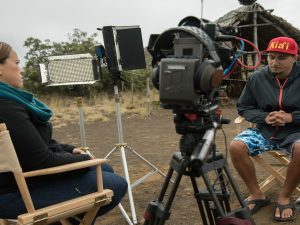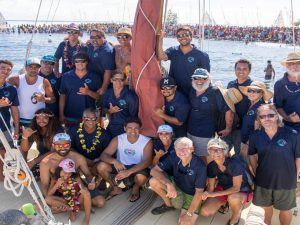I loko nō o ka hoʻomākaukau kino ʻana no huakaʻi holo puni honua ma luna o nā waʻa kaulua kaulana o Hawaiʻi nei, ua like a ʻoi aku paha ke koʻikoʻi o ka hoʻomākaukau ʻana i ka noʻonoʻo a keu aku, ka ʻuhane… ma o ke mele. Aside from physical training, the Worldwide Voyage requires spiritual and mental stability, which is being practiced through mele.
“Ma o ka hoʻopuka ʻana i nā mele, nā pule, kēlā ʻano, pēlā nō e kāhea aku ai i nā kūpuna, nā ʻaumākua, nā akua kekahi, no ka mea, maopopo iā kākou, mau nō lākou a na lākou nō e alakaʻi. Chants and songs allow us to call out to our ancestors for guidance,” said May Kawailanaokeawaiki Saffery, a member of the Worldwide Voyageʻs cultural protocol committee.
He kuanaʻike kēia i ulu i waena o nā ʻaukai ʻimiloa mai ka wā i holo mua ai ʻo Hōkūleʻa i Kahiki. This understanding has grown within each crewmember since Hōkūleʻa’s first journey to Tahiti.
“In the very beginning when Hōkūleʻa was first launched and when we were learning to sail, we were busy learning how to sail, so we used to delegate protocol to some respected kupuna or elder who knew how to do that,” said pwo navigator Kālepa Baybayan.
I kēia manawa, he kuleana kēia no ka ʻohana waʻa holoʻokoʻa, keu hoʻi nā ʻōpio. Protocol is now a responsibility for all, especially those who are younger.
“Ua aʻo mākou ʻekolu, ʻo Keoni Kuoha, Kaleo Wong, a ʻo wau i ʻēhā mau mea. Kekahi pule hoʻomaikaʻi, Keoni, Kaleo and I have helped to teach four compositions. A prayer, a greeting chant, the original Ka Naʻi Aupuni, and Keoni’s very own, ʻKākī o Nā Hōkū.ʻ” said Maya.
“Ma kēlā mele e wehewehe i ke ʻano o ka holo ʻana, no ka nākiʻi ʻana, i nā hōkū, ka hoʻomākaukau i ka waʻa no ka holo ʻana ma ka moana. A aia nō a mākaukau kēia mau mea, a holo nō ka waʻa. This mele describes everything about sailing. From the tying of knots to the stars and preparation. Only until these things are mastered, are you ready to sail,” said Hikianalia watch captain Kaleo Wong.
Akā e like hoʻi me kā kākou no ka hoʻomākaukau pono ʻana no kēia huakaʻi holo puni honua, aia ka waiwai o ua mau pono lako kino i ko ka ʻaukai ʻimiloa mākaukau poʻo. A e like me ka ʻōlelo o ko kākou poʻe kūpuna, “Aʻohe pau ka ʻike i ka hālau hoʻokahi.” However, these physical components work in alignment with our knowledge. And as our ancestors once said, we have many sources from which to grow such knowledge.
“He kā, he iwi, he makau, he lupe, ua lako ka ipu a ka hoʻokele. Ke loaʻa kēia mau mea, lako ka ipu a ka hoʻokele. Ke noʻonoʻo kākou, kēia ipu, ʻaʻole ia he ipu e paʻa ma ka lima, kēia mau mea e komo ai ma loko o ka ipu, ʻaʻole ia he mea e paʻa ma ka lima a hoʻokomo i kēlā ipu, ʻo ka ipu, ʻo ia ka waihona noʻonoʻo me ka naʻau o ke kanaka, ʻo ka hoʻokele nō hoʻi. A canoe bailer, a line, a hook, and a sail are all the things a navigator needs. Dig deeper and you will see that all of these things are the knowledge that the navigator must have in his ipu, or his memory bank in order to sail,” said Kaimana Bacarse, a crew member with Nā Kālai Waʻa.
“Maopopo nō iā mākou, he mau loina ko kēlā me kēia kanaka, a makemake e mahalo i kēia mau mea, so mākou ʻekolu, hōʻike, aʻo i kēia mau mea ʻēhā me ka manaʻo, he kahua wale nō ia. Ma luna aʻe e kūkulu ʻia ai i nā loina, i nā kuʻuna, ʻē aʻe, mai nā ʻohana waʻa like ʻole. No ka mea, he ʻohana nui- he hoʻokahi ʻohana kākou, so makemake e mahalo i nā mea a lākou e lawe mai ai, e aʻo mai ai. We understand that each waʻa community has their own custom practices, so what we teach is just a foundation for everyone to build from. Our combined practices create this one big family that we are all a part of, and I appreciate that,” said Maya.
Ke noʻonoʻo kākou, ʻo ke oli a me ke mele, pēlā e paʻa ai nā moʻolelo o kākou i kēia wā ʻoiai, a pēlā i paʻa ai nā moʻolelo o nā poʻe o ka wā kahiko. These mele are what will keep our stories alive for many generations, as those of our ancestors have,” said Kaimana.



